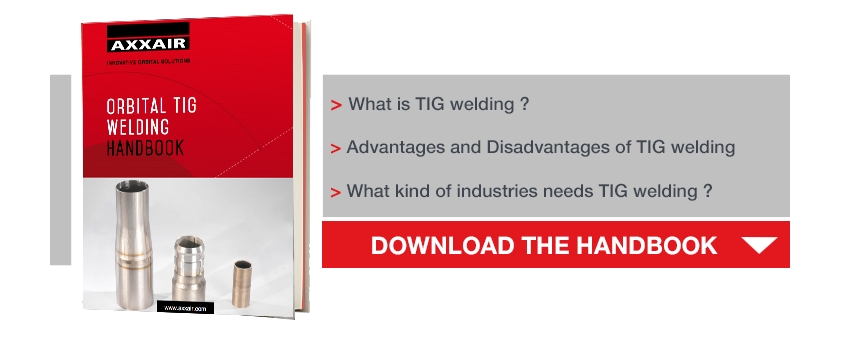Orbital welding was developed in the 1960s in order to meet the high standards of the aerospace industry and in particular to provide the necessary integrity of components used in hydraulic systems for example.
An automated TIG (GTAW) welding process
TIG-welding can be automated very easily when it comes to simple fusion welding (butt welding) but also when using filler wire for thick walled pipes.
Since the torch is mobile and the workpiece is fixed, this process is particularly well suited for welding tubes and pipes. Welding "in position" is also greatly facilitated, as the machine can move around the tube that might already been welded on one side.
When welding stainless steel tubes and pipes with the automated TIG welding process, several factors influence the repeatability of results. Said repeatability is key when it comes to automating a welding process. Influencing factors can be the following:
- the shape of the tungsten electrode
- the pressure of the purge gas inside the pipes
- the purity of the purge gas
- surface preparation
- etc ...
For manual welding, the preparation of the parts that are to be welded is already important but when it comes to orbital welding, it is indispensable. The surface condition of the tube has an immediate impact on the quality of the weld. For thin walled tubes with thicknesses under 3mm it is therefore advised to make use of orbital squaring (facing) which gives you a perfect, burr-free surface.
>> DOWNLOAD YOUR ORBITAL TIG WELDING HANDBOOK <<
For which industries can automated welding be of use?
This type of welding procedure is used in the semi-conductor industry for tubes transporting pure gases,in the pharmaceutical industry for transporting pure water (i.e. for injections), in the food and beverage industry, in the chemical and petrochemical industry, in the nuclear industry as well as in the aerospace industry for welding titanium tubes.
Orbital welding is a very reliable process, but it is nonetheless beneficial to be familiar with the equipment, in particular in regard to the quality of electrodes and gases used and the quality of all elements involved in the welding process including the tubes, the weld seams and the welding current.
Once these factors are under control, orbital TIG welding shows defects in less than 1% of the results. Even close to 0% when the following factors have been checked:
- quality of the tubes and accessories (no difference in wall thickness, no out-of-round pipes that can lead to defects)
- preparation of the parts that are to be welded (cutting, beveling, squaring, …)
- docking
- quality of gases and electrodes
- functionality of the equipment
Numerous metals can be welded
Since its beginnings, orbital welding has almost always been associated with the TIG process, also called GTAW process, and a non-melting tungsten electrode, except in certain cases when it is necessary to work with cold wire. Numerous metals can be welded: the hardest, most heat and corrosion resistant steels, unalloyed and low-alloyed carbon steels, nickel alloys as well as titanium, copper, aluminum and all their alloys. TIG welding is carried out under controlled conditions within a protective atmosphere. It is extremely clean, generates only very few particles and avoids any undesirable splashes. While it was primarily intended for welding stainless steels, it meets the highest standards in terms of mechanical quality as well as aesthetics.
Automated parameters to guide the operator
The interface between man and machine allows for a very intuitive use of the orbital welding equipment. This makes the procedure accessible for personnel that has not necessarily been trained as a welder.
In the majority of cases and especially with the models of the latest generation, an integrated auto-calculation system sets the parameters to guide the operator towards an already optimized welding result. An orbital welding machine has to counteract gravity because the tube is immobile. For that reason, the power source automatically and precisely controls the welding parameter such as energy input in order to compensate for gravity and the heating up of the tube during the welding.
Orbital welding remains due to its implementation on the mechanical level (guiding the electrode around the tube) as well as on the electronic level (sophisticated, communicating power supplies) a bigger investment than a manual TIG welding set.
Click on the image below and download our guide to learn more about orbital welding! 📕🎓



